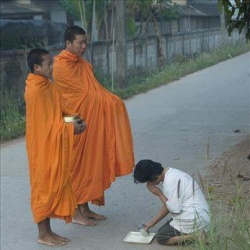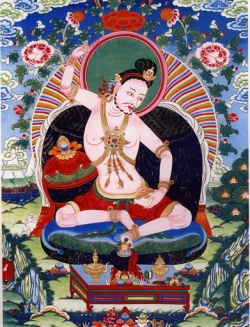Difference between revisions of "Rime"
| Line 44: | Line 44: | ||
The [[Rimé]] {{Wiki|concept}} was not original to [[Kongtrul]] and [[Khentse]] - neither were they new to [[Buddhism]]! The [[Lord Buddha]] forbade his students even to criticise the teachings and [[teachers]] of other [[religions]] and cultures. The message was so strong and unambiguous that [[Chandra Kirti]] had to defend [[Nagarjuna's]] treatises on [[Madhyamika]] by saying, "If, by trying to understand the [[truth]], you dispel the misunderstandings of some [[people]] and thereby some [[philosophies]] are damaged - that cannot be taken as [[criticising]] the [[views]] of others" ([[Madhyamika-avatara]]). A true [[Buddhist]] cannot be but [[non-sectarian]] and [[Rimé]] in their approach. | The [[Rimé]] {{Wiki|concept}} was not original to [[Kongtrul]] and [[Khentse]] - neither were they new to [[Buddhism]]! The [[Lord Buddha]] forbade his students even to criticise the teachings and [[teachers]] of other [[religions]] and cultures. The message was so strong and unambiguous that [[Chandra Kirti]] had to defend [[Nagarjuna's]] treatises on [[Madhyamika]] by saying, "If, by trying to understand the [[truth]], you dispel the misunderstandings of some [[people]] and thereby some [[philosophies]] are damaged - that cannot be taken as [[criticising]] the [[views]] of others" ([[Madhyamika-avatara]]). A true [[Buddhist]] cannot be but [[non-sectarian]] and [[Rimé]] in their approach. | ||
</poem> | </poem> | ||
| + | |||
| + | |||
| + | |||
| + | |||
| + | |||
{{R}} | {{R}} | ||
[http://acalavidyaraja.blogspot.com.au/2013_02_01_archive.html acalavidyaraja.blogspot.com.au] | [http://acalavidyaraja.blogspot.com.au/2013_02_01_archive.html acalavidyaraja.blogspot.com.au] | ||
| + | [[Category:Buddhist Terms]] | ||
| + | [[Category:Buddhism]] | ||
| + | [[Category:Tibetan Buddhism]] | ||
[[Category:Rimé]] | [[Category:Rimé]] | ||
Latest revision as of 17:59, 5 April 2023
Rimé (རིས་མེད་, Wyl. ris med) — the ecumenical, non-partisan or non-sectarian movement begun by Jamyang Khyentse Wangpo and Jamgön Kongtrul and their disciples in Kham in the nineteenth century.
Rimé (Tib.) Tibetan religious movement which developed in Eastern Tibet from the 1860s on-wards among all the non-Gelukpa traditions, including the Bonpo ( . Different Rimé teachers had differing views, but all tended to emphasise the need to maintain a plurality of paths and methods, and saw the various methods as united through their common goal. Dzogch’en (q.v.) and the Terma (q.v.) traditions were important for the Rimé lamas, and many of the leading figures were themselves Tertön (q.v.). Some were also involved in the revival of the Shentongpa teachings, though not all were Shentongpa.
What is Rimé?
Khenpo Puntsok Namgyal says:
- The word Rimé (རིས་མེད་, Wyl. ris med) literally means 'unbiased' or 'non-partisan'. The opposite of rimé, bias or prejudice (Tib. རིས་སུ་ཆད་པ་, ris su chad pa), means being attached to one's own group or one's own tradition and having aversion towards others. In a broader sense, therefore, it can apply to all forms of bias and prejudice, including nationalism and racism, or even being attached to one's own town or family and thinking they are the best. Specifically in terms of the Dharma, bias or sectarianism means having attachment to one's own tradition and aversion to others. Of course, all the teachings of the Dharma are beyond this prejudice, and act as an antidote to attachment and aversion, but the Rimé tradition, as begun by Jamyang Khyentse Wangpo, placed special emphasis on the need to be free from this kind of sectarian bias, and was also characterized by the active propagation of teachings from all the practice lineages that existed in Tibet at that time. There had been teachers in the past who had practised the teachings of different traditions, but the Rimé movement was extraordinary in how its followers sought out all the transmissions that remained intact at that time in Tibet and then did all they could to preserve them and spread them as widely as possible.
Teachings on Rimé Given to the Rigpa Sangha
- Khenpo Puntsok Namgyal, Lerab Ling, 14 June 2007
- Orgyen Tobgyal Rinpoche, Lerab Ling, 25 August 2008
Further Reading
- E. Gene Smith, '‘Jam mgon Kong sprul and the Nonsectarian Movement' in Among Tibetan Texts, Wisdom, 2001
- Ringu Tulku, The Ri-me Philosophy of Jamgön Kongtrul the Great (Boston & London: Shambhala Publications, 2007)
RIMÉ (Tib.) Tibetan religious movement which developed in Eastern Tibet from the 1860s onwards among all the non-GELUKPA traditions, including the BONPO (see FOUR MAIN ORDERS). Different Rimé teachers had differing views, but all tended to emphasise the need to maintain a plurality of paths and methods, and saw the various methods as united through their common goal. DZOGCH’EN (q.v.) and the TERMA (q.v.) traditions were important for the Rimé lamas, and many of the leading figures were themselves TERTÖN (q.v.). Some were also involved in the revival of the SHENTONGPA teachings, though not all were Shentongpa.
Source
Ris or Phyog-ris in Tibetan means "one-sided", "partisan" or "sectarian". Med means "No". Ris-med (Wylie), or Rimé, therefore means "no sides", "non-partisan" or "non-sectarian". It does not mean "non-conformist" or "non-committal"; nor does it mean forming a new School or system that is different from the existing ones. A person who believes the Rimé way almost certainly follows one lineage as his or her main practice. He or she would not dissociate from the School in which he or she was raised. Kongtrul was raised in the Nyingma and Kagyu traditions; Khentse was reared in a strong Sakyapa tradition. They never failed to acknowledge their affiliation to their own Schools.
Rimé is not a way of uniting different Schools and lineages by emphasising their similarities. It is basically an appreciation of their differences and an acknowledgement of the importance of having this variety for the benefit of practitioners with different needs. Therefore the Rimé teachers always take great care that the teachings and practices of the different Schools and lineages and their unique styles do not become confused with one another. To retain the original style and methods of each teaching lineage preserves the power of that lineage experience. Kongtrul and Khentse made great efforts to retain the original flavour of each teaching, while making them available to many.
Kongtrul writes about Khentse in his biography of the latter.
"Many people these days become involved and confused in the assertion and negation of so-called philosophical differences such as Rangtong and Shentong, etc. They try to win everybody over to their side to the point of breaking their necks! When he (Khentse Rinpoche) taught, he would give the teachings of each lineage clearly and intelligibly without confusing the terms and concepts of other teachings. He would then advise his students and would say:
'The ultimate subject we need to define is the Ultimate Nature, or Dharmata, of phenomena. The Prajna-paramita Sutra says, "Dharmata is not knowable (with the intellectual mind) and cannot be perceived in concepts". Even Ngog Lotsawa, the jewel on the head of all Tibetan logicians, says, "The Ultimate Truth is not only beyond the dimension of language and expression, but it is also beyond intellectual understanding". The Ultimate Nature cannot be fully measured by our samsaric mind. The great saints (Siddhas) and scholars examined it from different aspects, and each of the ways outlined by them has many reasons and logical sequences. If we follow the tradition of our own lineage and study our own lineage masters in depth, we shall find no need to feel sectarian. However, if we confuse the terms and systems of different traditions, or if we try to introduce the ways of other systems because we do not have a deep understanding of our own tradition, we shall surely make our minds as muddled as the yarns of a bad weaver. The problem of being unable to explain our own traditional teachings arises out of ignorance of our own studies. If this happens, we lose our confidence in our own traditions; neither are we able to copy from others. We become a laughing stock for other scholars. Therefore it is best to understand thoroughly the teachings of our own School.'
This way we can see the harmony of all paths. All teachings can be seen as instructions and therefore the roots of sectarian feelings should shrivel and die. The Lord Buddha's teachings will take root in our minds. The doors to the 84,000 groups of teachings will open up at one time."
The Rimé concept was not original to Kongtrul and Khentse - neither were they new to Buddhism! The Lord Buddha forbade his students even to criticise the teachings and teachers of other religions and cultures. The message was so strong and unambiguous that Chandra Kirti had to defend Nagarjuna's treatises on Madhyamika by saying, "If, by trying to understand the truth, you dispel the misunderstandings of some people and thereby some philosophies are damaged - that cannot be taken as criticising the views of others" (Madhyamika-avatara). A true Buddhist cannot be but non-sectarian and Rimé in their approach.


